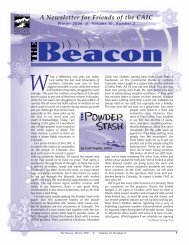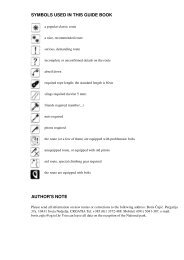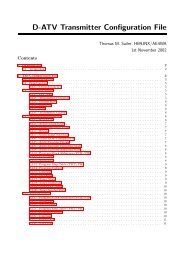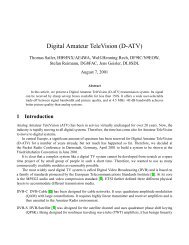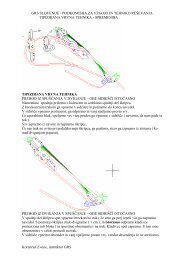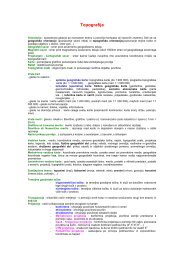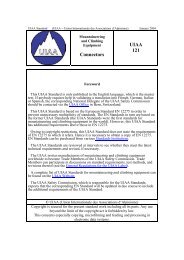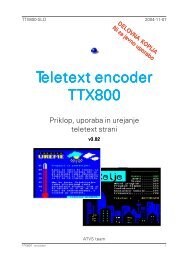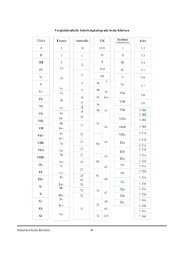other snow safety essentials from backcountry access
other snow safety essentials from backcountry access
other snow safety essentials from backcountry access
Create successful ePaper yourself
Turn your PDF publications into a flip-book with our unique Google optimized e-Paper software.
OPTIONS<br />
D<br />
%<br />
a t<br />
S<br />
E<br />
A<br />
R<br />
C<br />
H<br />
st a rt<br />
u p<br />
TRANSMIT<br />
Operating Instructions<br />
Operating Instructions<br />
Mute Mode<br />
To mute the sound while in search mode, push the options button<br />
(6) for three seconds until “LO” is displayed, then release. To<br />
turn the speaker back on, perform the same operation. “L1” will<br />
be displayed, indicating the speaker is back on.<br />
OPERATING INSTRUCTIONS<br />
Searching<br />
The Tracker DTS operates using the 457 kHz international<br />
standard frequency. It is fully compatible with all avalanche<br />
transceivers adhering to this standard. Do not use with 457kHz<br />
transceivers designed for firefighter rescue.<br />
The search process includes three phases: the signal (or primary)<br />
search, the fine (or secondary) search, and the pinpoint<br />
search.<br />
Signal/Primary Search<br />
The signal search refers to the process of establishing a search<br />
pattern and looking for a signal. The search pattern will be<br />
defined by the victim’s last seen area, the size of the slide, and<br />
the number of searchers. Refer to Figures B and C, below, to<br />
establish a primary search pattern. If the slide is less than 20<br />
meters wide, the primary search path will be directly down the<br />
center. If the victim’s last seen area is well defined, the primary<br />
search will follow a direct path down the fall line <strong>from</strong> this point.<br />
10<br />
Figure B Primary Search<br />
One searcher/Slide wider than 20 meters<br />
10m<br />
10m<br />
Area last seen<br />
20m<br />
20m<br />
20m<br />
10m<br />
Figure C Primary Search<br />
Multiple searchers/Slide wider than 20 meters<br />
10m<br />
Area last seen<br />
20m<br />
20m<br />
10m<br />
Direction<br />
of search<br />
path<br />
Figure D<br />
Primary/Signal search<br />
Rotate the Tracker slowly<br />
in your hand, but move<br />
rapidly down the search<br />
path. Do not abandon<br />
your search path until you<br />
have captured a strong,<br />
steady signal. Ignore irregular<br />
signals, which can<br />
sometimes be caused by<br />
electrical interference.<br />
Prior to the primary search, be sure that all transceivers are<br />
turned to search mode. Rotate the Tracker slowly back and forth<br />
on a horizontal and vertical plane (Figure D) while moving in<br />
the direction as defined by your primary search pattern. While<br />
searching, be aware of <strong>other</strong> physical clues, such as equipment<br />
or extremities protruding <strong>from</strong> the <strong>snow</strong> surface. When no signal<br />
is detected, “SE” will flash in the distance indicator. Once a<br />
signal is detected consistently, mark this spot and begin the fine<br />
search.<br />
Secondary/Fine Search<br />
The secondary search (also referred to as the fine search) is the<br />
portion of the search <strong>from</strong> where you have detected a steady<br />
signal to where you are close to the victim.<br />
Once the signal is consistently detected, rotate the Tracker<br />
slowly on a horizontal plane until the center direction light (7)<br />
is blinking. The Tracker is now pointed in the direction of the<br />
strongest signal, or your direction of travel (Figure E). The four<br />
lights (7) on either side of center tell you which way to rotate<br />
the Tracker to engage the center light. The distance indicator<br />
Figure E<br />
Windows<br />
The Tracker is very sensitive. Slight<br />
movement in any direction will actuate<br />
a different search light. Rotate it<br />
very slowly so as not to “skip” over<br />
the center search light window.<br />
In special (SP) mode, signals<br />
are only displayed if they fall<br />
within the center three<br />
windows.<br />
Direction of<br />
strongest signal<br />
B a tt e r y<br />
I S T A N C E<br />
11<br />
ENGLISH




